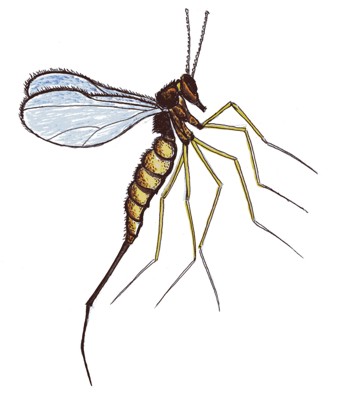Pests
Contarinia pisi Winnetz - Pea midge
Systematic position.
Class Insecta, order Diptera, family Cecidomyiidae, subfamily Cecidomyiinae, genus Contarinia.Biological group.
Olygophagous- pest of leguminous cultures.Morphology and biology.
The body of imago is gray-yellow, length about 22 mm. The hairs on transparent wings form a drawing. The venation is simple. Antennae are brown-yellow with peduncle (the segments of female are cylindrical, male are spherical). Palpus consist from 4 segments. Legs are also gray-yellow. First segment of tarsus is shorter than second, claws without denticles. Empodium is easily visible. Ovipositor is marked as very long (needle-like), pointed at the end. Threadlike egg is white, pupa - brown-yellow. The overwintering takes place at the phase of larvae in puparium (usually in cocoon) in the ground (depth of 3-5 cm). In the spring insects leave the puparium, they become nonactive (before pupa period). Pupa is developed 4-8 days. The overwintering generation begin flying at mass budforming of pea and others leguminous cultures, also beginning of blossoming (in the zone of strong harming activity it is second part of May and beginning of June). Coupling takes place on the same day. The female lays eggs in the green buds of pea, piercing by ovipositor. The fecundity of one female is about 20-80 eggs; it populates 20 flowers. The embryonal period lasts 4-11 days, larval period- 9-14 days. At feeding larvae damage flowers which become expended, forming a gall. Larvae finish the feeding, leave the flower, fall into the ground, where they become the pupa. One part of population goes into the diapause (without pupation) and spend the winter. Larvae of second generation feed in pods. Damaged pod is increased. Seeds become small, light. At pod drying larvae are located in one end; the pod is split, larvae fall on the ground. From 70 to 80 larvae are developed in one pod, maximal - 200-300. Flying of second generation is observed at the end of June- beginning of July; third generation in July- beginning of August. Life span of insect is about 24-36 days.Distribution.
Species is spread in Europe. Within the territory of the Former USSR, species occurs in Ukraine, Baltic States, Byelorussia, European part of Russia. Its harmful activity is reported in central, western, northern part of Ukraine, in Central Black Earth zone. The harmfulness is characterized as low.Ecology.
The pupation of insect is observed at the daily temperatures 13-16°C. The most favorable conditions for phytophagous are at the temperature 20-22°C and relative humidity 70-80%. Soil moisture and moderate amount of precipitation are also important. Pest gives 2-3 generations during the year. Most important entomophagous are: Systasis encyrtoides Wlk., Inostemma panici Sel., Eupelmus alboannellatus Bel.Economic significance.
The species is oligophagous. It damages flower buds of leguminous cultures: pea, bean, lentils, vetch. Most harming activity is marked on pea and bean. Damaged flowers become deformed, dark, fall to the ground. Pods are increased, seeds become small, wrinkled. The harmfulness of pea midge within the territory of the Former USSR is characterized as low. Control measures include due underwinter plowing, careful collection of seeds, crop rotations, insecticide treatments.Reference citations:
Karavyanskii N.S., Mazur O.P. 1975. Pests and diseases of fodder cultures. Moscow: Rossel'khozizdat. p. 156-160 (in Russian).Mamaev B.M. 1964. Family Cecidomyiidae- midges. In: Bei-Bienko G.Ya., ed. Keys to insects of the European part of the USSR. V. 5. Moscow & Leningrad: Nauka. P. 413(in Russian).
Rakauskas P.1962. Insects- pests of pea in Lithuanian SSR and control measures. PhD Thesis. Vilnius, State University, 19 p. (in Russian).
Vasil.ev V.P., ed. 1973. Pests of agricultural crops and forest plantations. 1. Kiev: Urozhai. 514 p. (in Russian).


